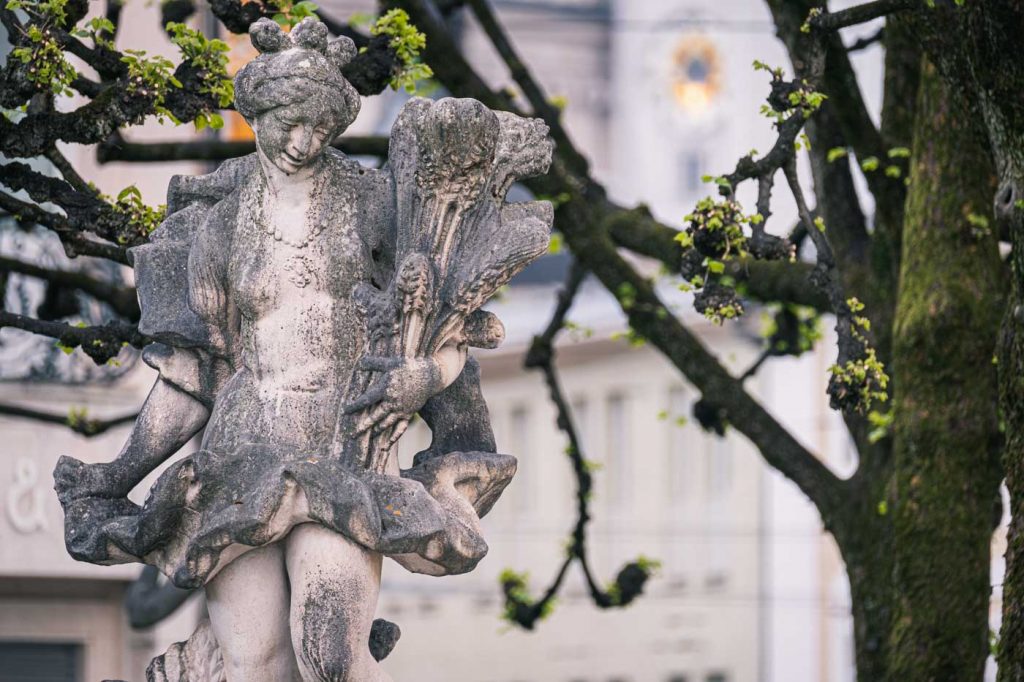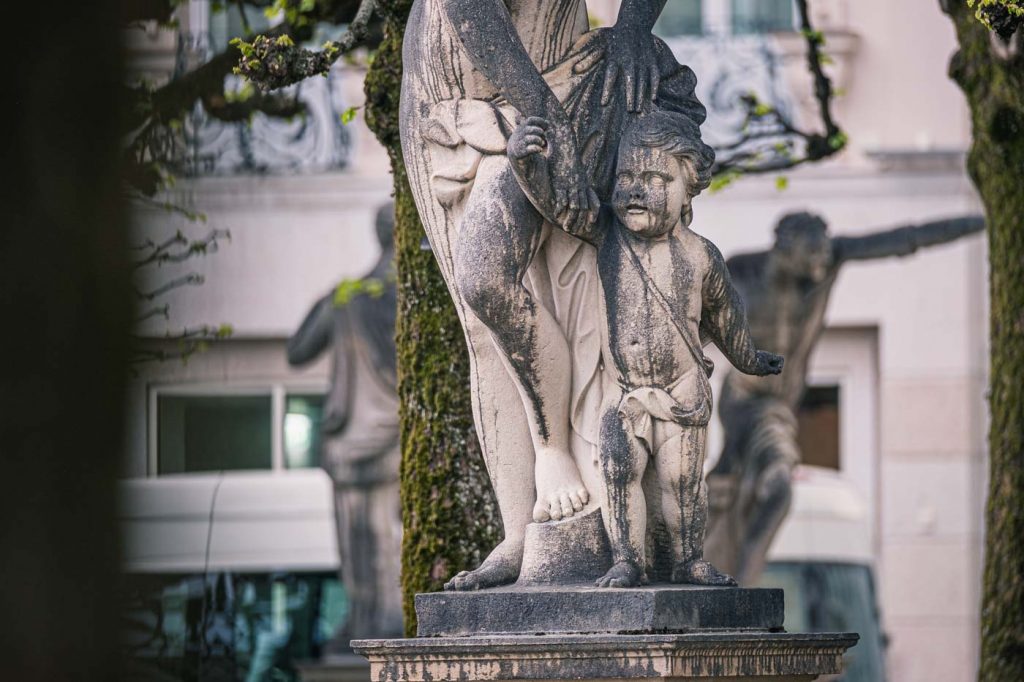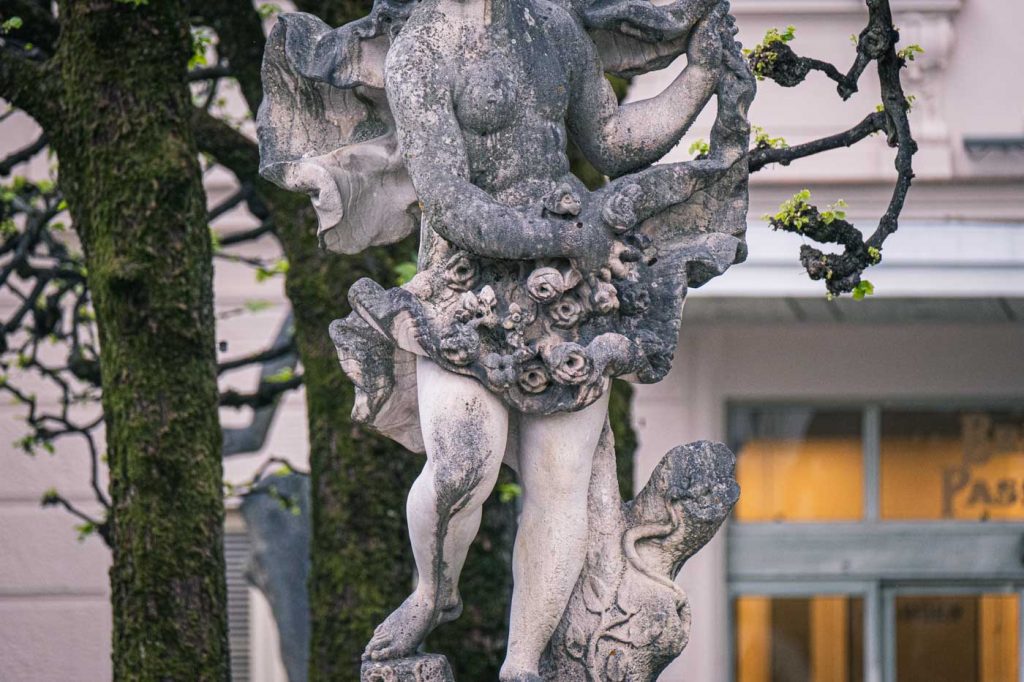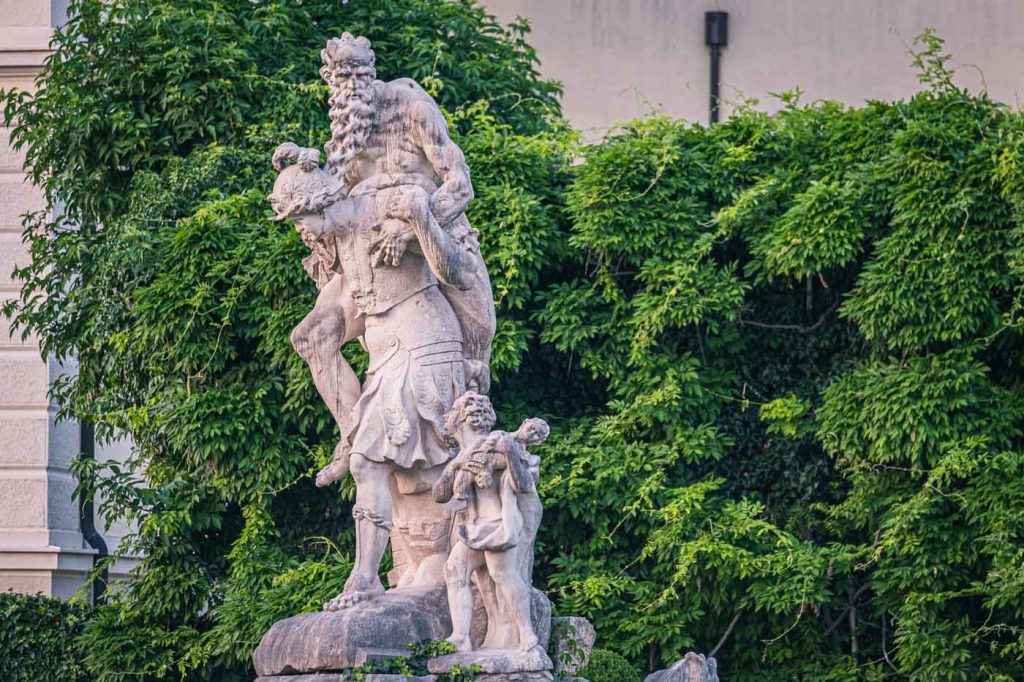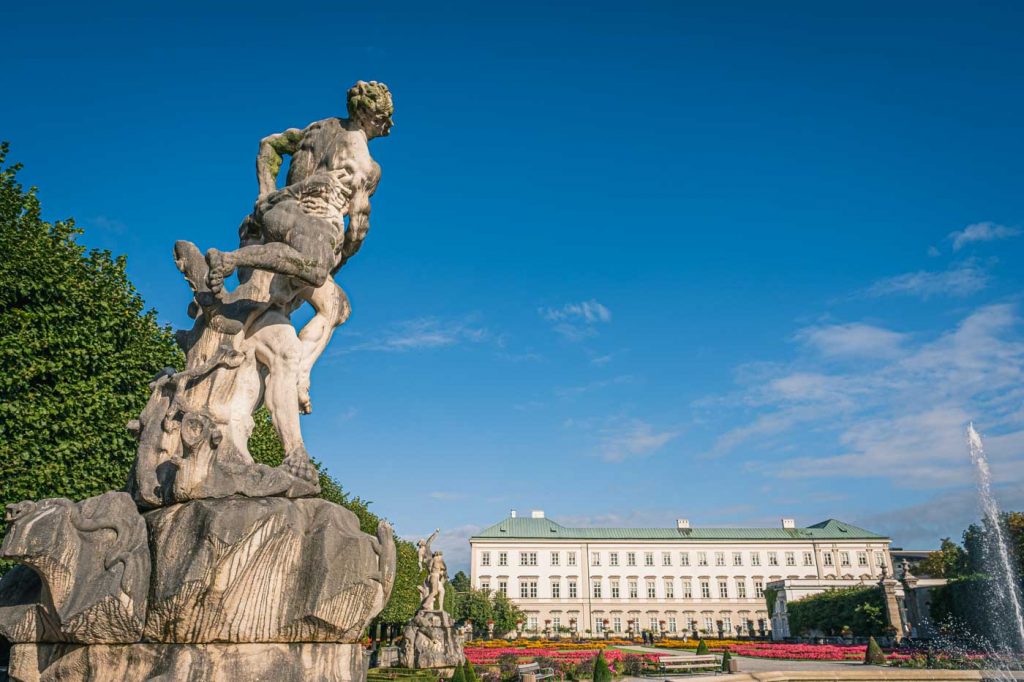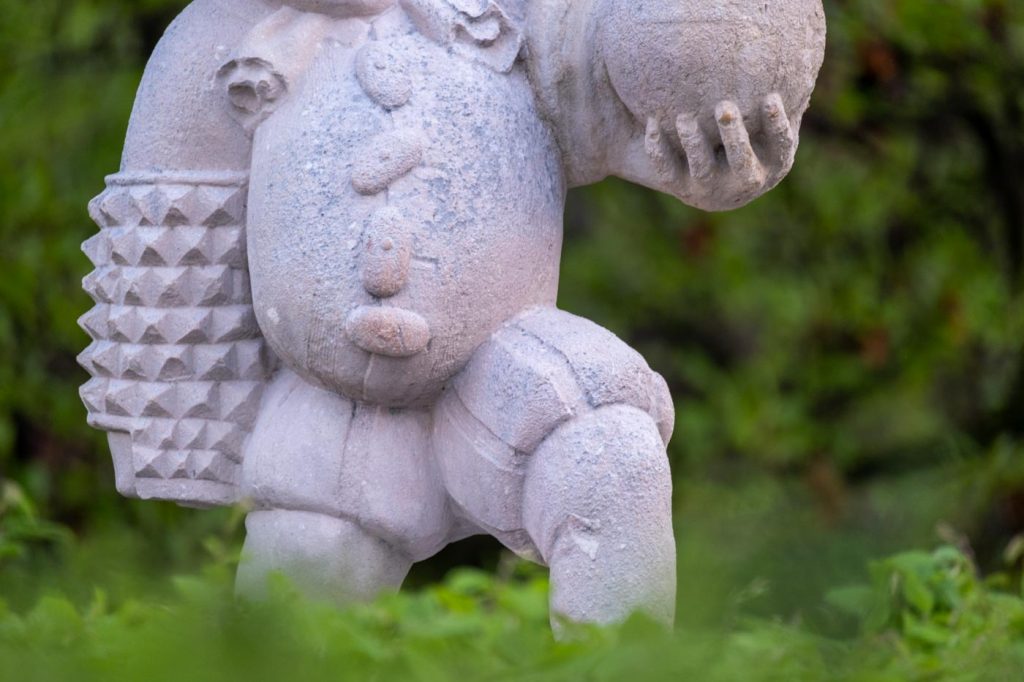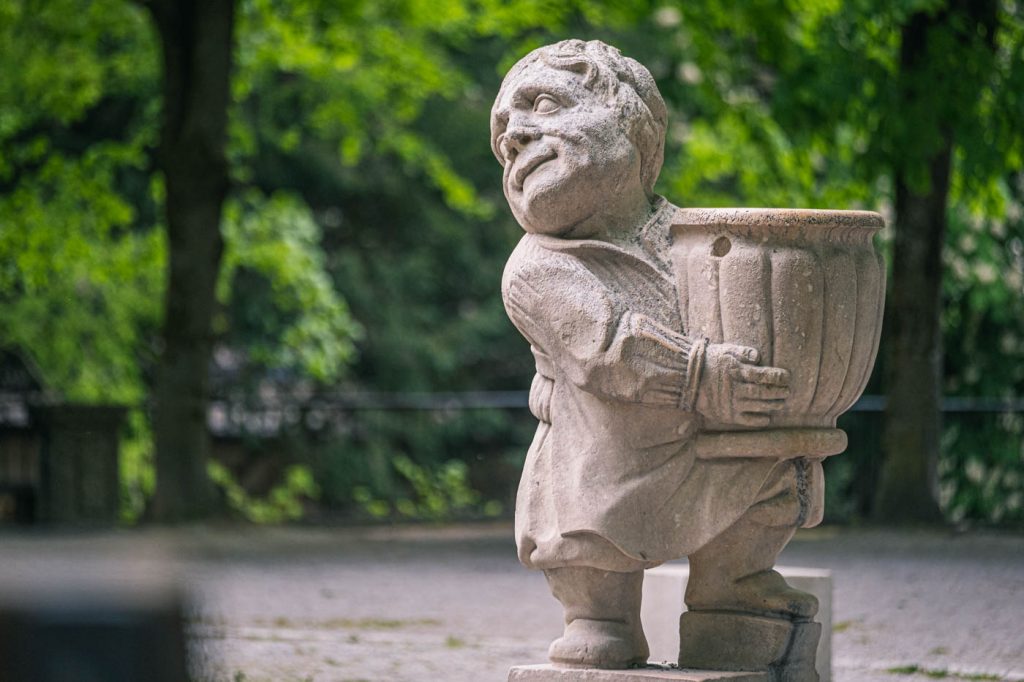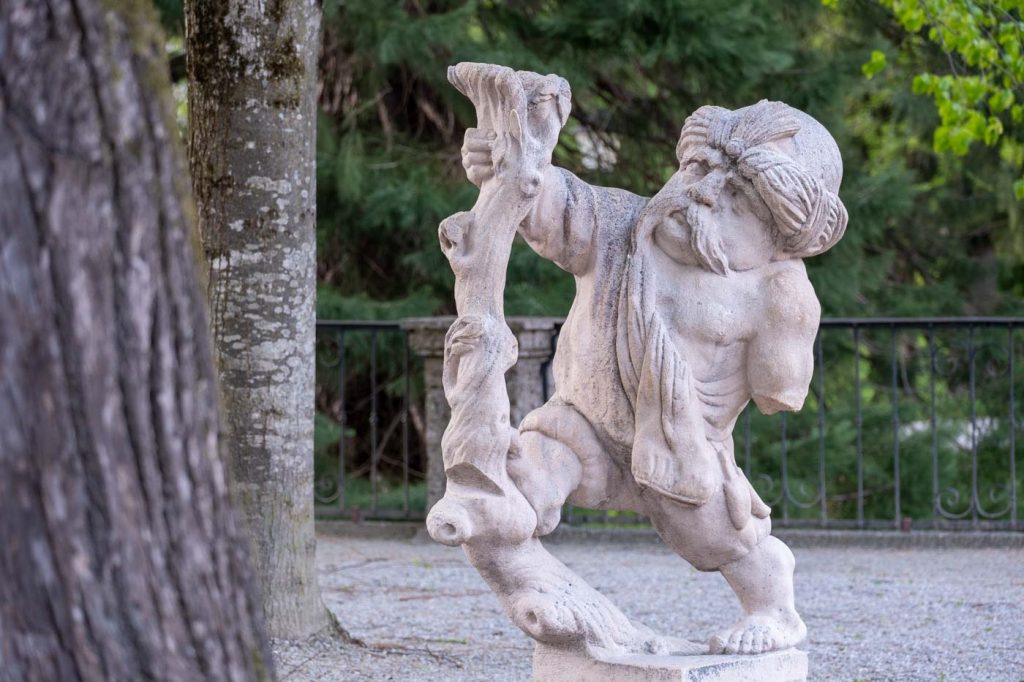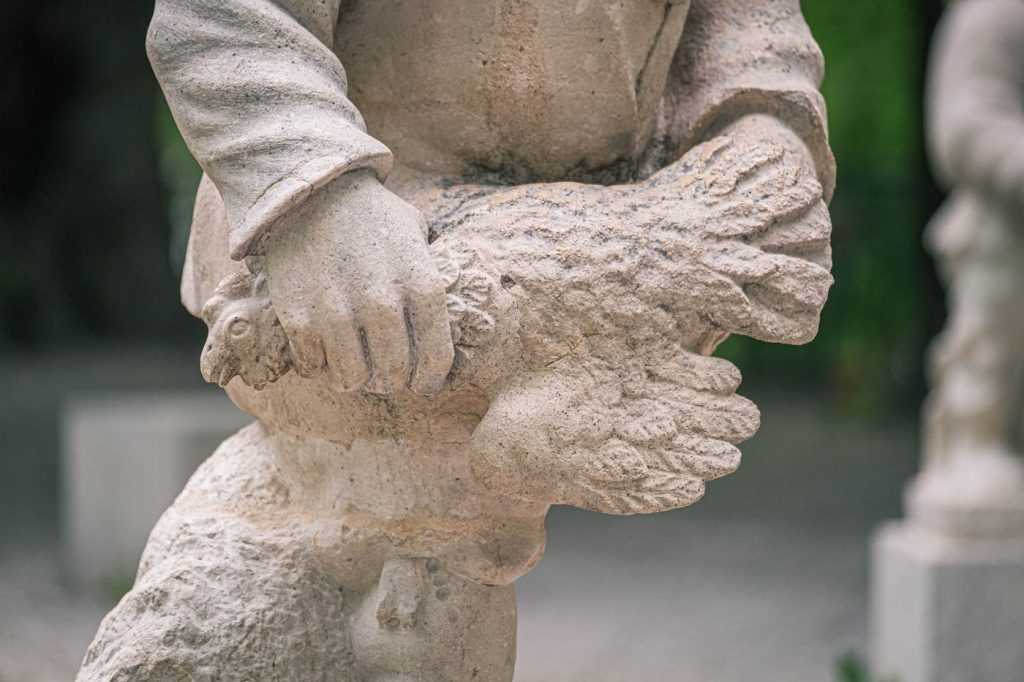The Mirabell Palace and Gardens, the baroque jewel of Salzburg, is one of the Top 3 sights of Salzburg. In Salzburg, the entire old town on the left side of the Salzach river is a UNESCO world heritage site, but on the right side of the river, only Mirabell is so designated. Mirabell is a must for every visitor to Salzburg.
With this guide, you’ll be more than just a visitor. With this guide to the Mirabell Gardens, you will become an explorer and discover every story and every little secret about the gardens. Let me tell you the history of Mirabell before we begin our walking tour!
The History of Mirabell Palace and Mirabell Gardens
Wolf Dietrich became archbishop of Salzburg at the end of the 16th century after studying in Italy for a decade. During his time in Italy, he developed an interest in Italian architecture. At the time, Italy was more advanced while Salzburg was still in the middle ages. Thus, Wolf Dietrich did not find Salzburg’s architecture a fitting representation of his power. He tore down many of the buildings in the old town, mostly around the cathedral on the left side of the river. Many of these buildings were not completed during his reign, but he laid the foundation for the baroque old town.
Mirabell, however, was not part of that old town. Mirabell was still outside the city walls at the time it was built. It was a kind of country house. In fact a countryside residence for Wolf Dietrich’s mistress and their 15 children. The castle was named Schloss Altenau (Altenau Castle) after his mistress Salome Alt.
Yes, I know. Archbishop. Mistress. Children.
Wolf Dietrich ended up a prisoner in his own fortress, but that’s a different story. He died there five years later. Markus Sittikus, his cousin, was envious and renamed the castle from Altenau to Mirabell to forget about the children’s story.
When baroque gardens were all the rage around 1700, the archbishop of Salzburg also wanted one and redesigned Mirabell Palace and the Garden. It was then that the Mirabell gardens as we know them today were created. Mirabell, however, remained the exclusive property of the archbishop, and later of the emperor. During Salzburg’s 50th anniversary of becoming a part of Austria, the emperor donated the gardens to the city as a gift. That’s when the Mirabell Gardens became a public park.
That’s why we can explore the gardens today, and that’s what we’ll do now.
Tour: Mirabell Gardens Self-Guided Walking Tour
We enter the Mirabell Gardens from Makartplatz, where the State Theater and Mozart’s residence are located. This is where we enter the garden when we come from the old town, for example on the Free Walking Tours. From the train station, you would enter the Mirabell from the other side, from the palace, whereas from Makartplatz we enter the garden from the other side and proceed to the palace.
1. Greek and Roman Statues in Mirabell Gardens
For the absolutist rulers of the time, Mirabell was a symbol of power. Heroes, gods, and demigods came in handy to compare themselves to. There are 28 Greek and Roman heroes and gods in Mirabell Garden starting at the entrance and continuing all the way into the palace.
Borghese Gladiators at the Entrance to Mirabell Garden
The four warrior statues at the entrance to Mirabell garden appeared in the Sound of Music where Maria and the kids imitated their posture. That’s what tourists still love to do nowadays.
In the 17th century, excavations in Italy revealed a similar object. That original warrior statue came from the palace of emperor Nero, which means that it’s almost 2000 years old. This figure was added to the Borghese family art collection in Rome, hence the name.
The statue became well-known and popular during the 17th and 18th centuries, and it became one of the most copied ancient works of art. Of course, the Salzburg Archbishop had to have a copy (or four).
Greek/Roman Gods Statue at Mirabell Garden’s Entrance
We have not yet entered the garden. Before entering the garden, have a look at the eight statues to the left and right of the entrance to Mirabell Garden. They represent male Gods. Here they are from left to right:
- Chronos: The God of time and father of Zeus. Symbol – Child
- Dionysus: The God of pleasure, madness, and wine. Symbol – Grapes
- Zeus: The king of Gods, God of the sky and of thunder. Symbol – Crown
- Ares: The God of War. Symbol – Shield
- Hercules: A Son of Zeus and Demigod. Symbol – Club
- Hephaestus: The God of Fire and Craftsmen. Symbol – Anvil
- Hermes: The Messenger of the Gods and the God of Thieves and Merchants. Winged Helmet
- Apollon: The God of the Sun, Light, Knowledge, Healing, disease, dance, archery, and more. Symbol – Bow and Arrows (but the bow is missing)

Greek/Roman Goddesses Statues at Mirabell Garden’s Entrance
Continue into the garden and past the second pair of Borghese gladiators to see the second row of eight statues. They represent female gods and unlike the male God’s statues are facing Mirabell Gardens:
- Artemis: Twin sister of Apollon and Goddess of hunters. Symbol – Dog and Bow (but the bow is also missing)
- Flora: Goddess of spring. Symbol – Flowers
- Athene: Goddess of War. Symbol – Shield with Medusas head
- Ceres: Goddess of summer and harvest. Symbol – Cereals
- Pomona: Goddess of autumn, fruit harvest, and abundance. Symbol – Grapes
- Aphrodite: Goddess of love. Symbol – Cupid portrayed as a Child
- Hestia: Goddess of Winter. Symbol – Thick coat
- Hera: Queen of all Gods and Goddess of marriage. Symbol – Peacock
See a pattern here? Flora, Ceres, Pomona, and Hestia are the female deities of the four seasons. Life was rougher in the past, so seasons were more important. The same goes for elements, which we will discuss next.
Let’s head to the center of the grand Parterre of Mirabell Garden!
The Four Elements Fountain of Mirabell Garden in the Center of the Grand Parterre
When you enter the garden, simply walk straight ahead until you are surrounded by four monumental statues. These statues have many more tales to tell.
You find traces for each of the Four Elements on the base of each statue.
- Paris and Helena – the Element of Water: The kidnapping scene on the right side, closer to the castle, shows Paris, the son of the Trojan king, abducting Helena from Sparta. Well, we all know how that kidnapping went. Since Paris and Helena were in love, the kidnapping was not exactly involuntary, as you can see from the statue in Mirabell Garden, but it caused 10 years of Trojan War, which led to the downfall of Troy.
Paris and Helena represent the element of water because Paris brings Helen overseas. - Aeneas and Anchises – the Element of Fire: The young guy, the old bearded one, and the child are Aeneas, his father Anchises, and his son Ascanius. They escape the burning city of Troy hence the element of fire. They settled in Italy where Ascanius became one of the first members of the Julians, the founding family of Rome, and the same family that Julius Caesar 500 years later belonged to.
- Hercules and Antheos – the Element of Air: Moving clockwise, we come to two men fighting to our left. Hercules, the son of Zeus, already greeted us at the entrance to Mirabell Garden. Antheos is his opponent. He lived in the Libyan desert and was kind of mean. Antheos asked everyone to wrestle with him, but his mother was Gaia, the earth and mother of all gods. He won every match because he was very grounded. Hercules, however, lifted Antheos and bear-hugged him to death. End of story.
Because he lifted him up, this statue in Mirabell garden represents the element of air. - Hades and Persephone – the Element of Earth: Another kidnapping is depicted in the last element, but this time the victim does not seem to be enjoying the experience. Hades is the god of the underworld and brother of Zeus. He fell in love with Persephone, the daughter of Zeus. Although Persephone was unhappy about going to the underworld, she later fell in love with Hades. Because he treated her well, she wanted to remain there.
Nevertheless, Demeter, the goddess of the harvest, was not pleased with her daughter’s decision and threatened to never harvest again. Persephone agreed to spend some time in the underworld and some time with her mother to solve the crisis. The beginning of winter comes with every time Persephone returns to the underworld because her mother stops working. Persephone is the goddess of the seasons.
Due to the underworld being underground, the earth is the last of the four elements.
2. Susanna from the Book of Daniel
BE AWARE that the part of the Mirabell Gardens that we enter now is not accessible in winter!
Next to the element fountain, facing the palace, you are in the middle of four statues. The route does not lead to the palace, but you take a left and walk until you see a half-naked woman at a fountain between the trees.
Her name is Susanna. Susanna lived in Babylon as a young, married woman. She was taking a bath one day when two old creeps approached her. The scene is depicted here in the Mirabell garden. If she refused, they threatened to spread rumors that she had cheated on her husband. But Susanna refused. She got into serious trouble as a result.
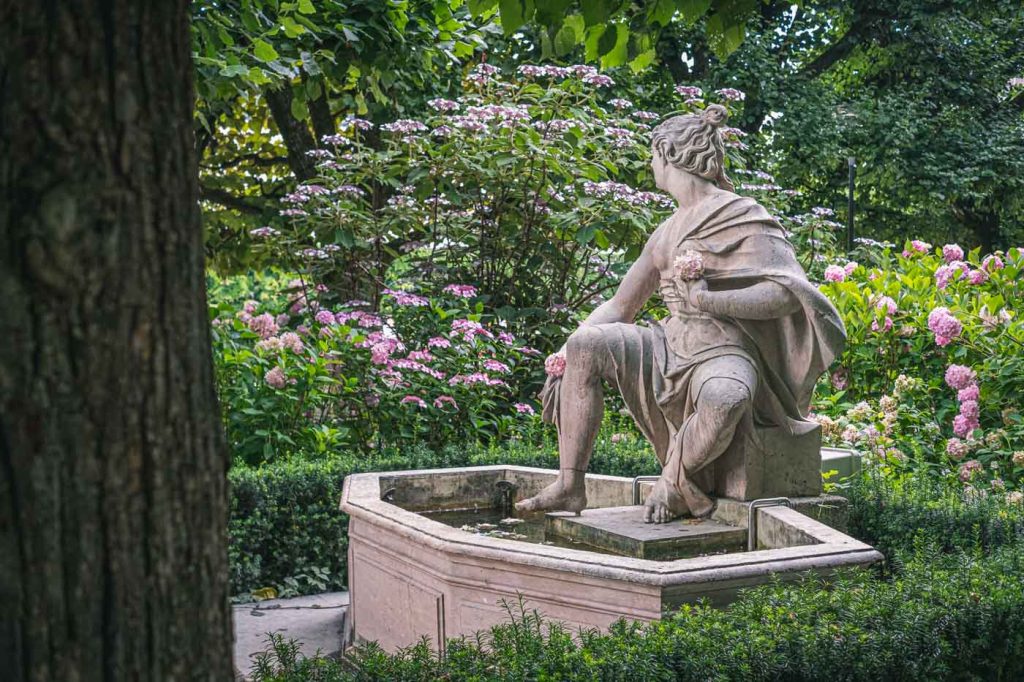
The hero of this story appears when she’s sentenced to death. Daniel, the prophet, recognized that something was wrong. It occurred to him that he might ask the two who testified at the trial questions. They were each asked separately where the adultery occurred and contradicted one another. This led to their execution, with Susanna escaping.
The fountain is the last piece of the inventory from Wolf Dietrich’s original castle. Do you remember him? The archbishop built Mirabell Castle for his mistress and their many children. We have no evidence that the Susanna fountain represents his beloved mistress, although it is possible. However, we do know that they were madly in love. Otherwise, they wouldn’t have had 15 children.
3. The Hedge Theater and a Secret of Mirabell Garden
You continue straight ahead towards the steps and the gate in front of you after looking at Susanna. We are headed to the hedge theater, but before we get there, just before the steps, turn left and look for the hedge tunnel. It was in the Sound of Music. Before we continue, you can take pictures of you replicating the jumps Maria and the kids made during the Do-Re-Mi Song.
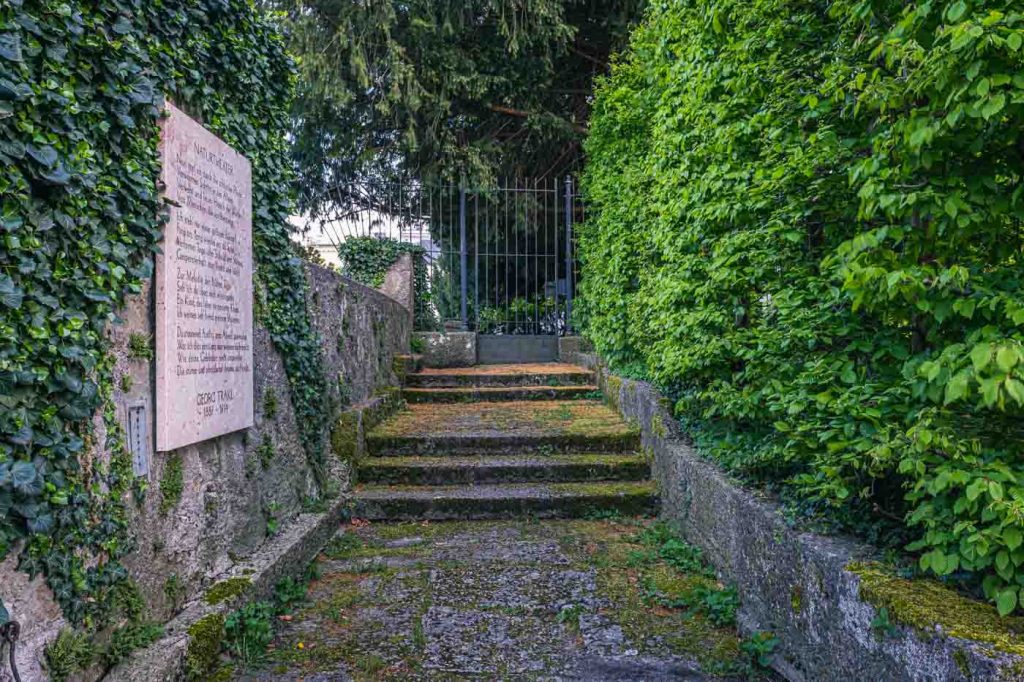
The Mozarteum Foundation and the Magic Flute House
Now take the first set of steps but not the second one. Turning left, you will see a few more steps, but after ten meters, a fence blocks your way.
The fence prevents you from entering the Mozarteum Foundation’s garden. The foundation was founded in 1842 in honor of 50 years of Mozart’s death.
However, that’s not what I wanted to show you.
I want to show you the wooden house in the corner. In this inconspicuous house, Mozart probably wrote parts of his most famous work, the Magic Flute. Mozart used to write only the music for his operas, not the story. Emanuel Schikaneder wrote the story of the Magic Flute. The rumor is, however, that Mozart was all over the place all the time.
Due to this, Schikaneder locked Mozart in that small wooden house so that he could finish the opera in time for the premiere. This story is a lie. An urban legend.
This wooden house was located at the Freihaustheater in Vienna, where the Magic Flute was first performed. We do not know what Mozart did there. The house was moved from Vienna to Salzburg and into the Mozarteum Foundation’s garden behind Mirabell Garden.
The Hedge Theater in Mirabell Garden
The next step is to continue climbing up the stairs, straight from where you came from. The Hedge Theater itself is self-explanatory. The archbishop and his guests were entertained there. This was an outdoor theatre and music venue. It even staged opera performances. Surrounding the stage you find some entrances and exits of a maze. The maze was used on the one hand to make musicians and actors appear and disappear and on the other hand for what you actually use a maze.
4. The Dwarf Garden Salzburg
You don’t have to descend into the main garden of Mirabell to reach the dwarf garden. Stay on the platform/wall next to the hedge theater and the maze and walk towards the palace. You will soon see two dwarfs guarding a small bridge on your left.
The History of the Mirabell Dwarf Garden
The dwarf statues in Mirabell were part of the entertainment of the Salzburg archbishop and his guests. The game was to guess what each dwarf’s symbol stood for. However, there was more to it than that.
Powerful people believed it was not only entertaining and trendy but also a symbol of status and good fortune to own people with dwarfism and present them to other kings and queens.
Rulers owned actual dwarfs. The archbishop of Salzburg owned actual dwarfs. They were also useful for public appearances. The person in power appeared bigger next to a dwarf.
During the beginning of the 19th century, with the revolutions, imperial courts fell out of favor, dwarfs out of style, and the trend to keep dwarfs vanished. The dwarf garden also disappeared.
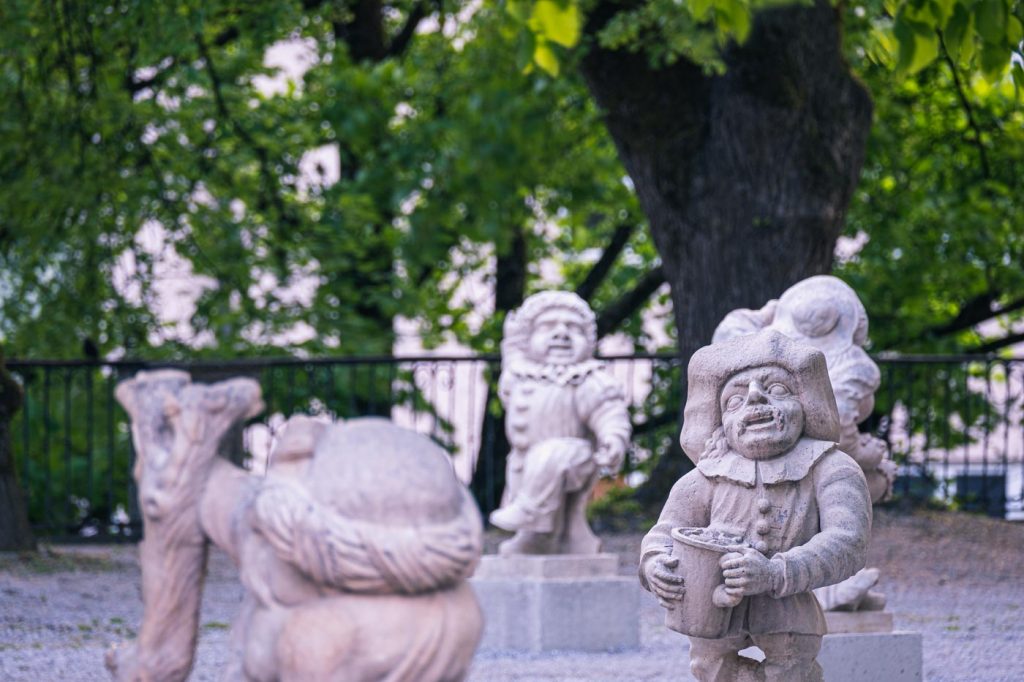
Mirabell originally had 28 dwarfs, but they were auctioned off. In 1919, only 15 were recovered, and two more in 2018 following much-needed renovations. The remainder remains in private gardens throughout Salzburg.
Mirabell Dwarf Garden Guide – Who are the 17 Dwarfs?
Let’s get the dwarf guessing going!
- Pallone Player Dwarfs: Two gnomes guard the bridge. One holds a ball. They are playing Pallone, a game similar to Volleyball where one team brings the ball into the other team’s field. But the balls were made of thick leather and weighed one or two kilograms. That’s why the other dwarf is wearing arm protection. Collateral damage in the form of broken bones was not uncommon in this game.
- Turkish Dwarf: After the bridge, we encounter a dwarf with a turban who tries to break a branch. The archbishop mentioned the second siege of Vienna by the Turks in 1683, just prior to the creation of the dwarfs. Like the dwarf, the Turks failed in their endeavor.
- The Monthly Dwarfs: Straight ahead you find a circle of twelve foundations and nine dwarfs. Each dwarf represents one of the months, with a symbol that mostly refers to the seasons. The month of January is represented by the dwarf with the chicken. In March the gardening begins, in April the plants are de-winterized, in June the gardening dwarf is already tired, the meadow was first mown in July, the August dwarf feels the heat, in September begins the fruit harvest. And I leave the December dwarf with the mug for you to interpret.
- Sound of Music Dwarf: Do you remember the Dwarf from the Sound of Music? Can you spot the dwarf that appeared in the movie? It’s the one on the right side when entering the garden. The one with the glasses. No wonder you couldn’t recognize him. When the movie was filmed in 1965 the dwarfs were in terrible condition. Now in 2020 they look cleaned and groomed again.
The Sound of Music dwarf is one of the comedians. He plays the role of a patient with the doctor. In the movie, Maria and the kids padded him on the head in the Do-Re-Mi Song.
Although dwarfs were already a thing, the dwarfs in Mirabell Garden formed the first dwarf garden in Europe and set off another fashion among nobles and rulers. However, while they got rid of their dwarfs in the early 19th century, the common folk doubled down on them. Through industrialization, it became possible to produce a large number of cheap dwarfs for private gardens, and the more the common people wanted the dwarfs, the less they appreciated them. And that’s the story of today’s garden dwarfs.
5. The Pegasus Fountain and the Do-Re-Mi Steps
When crossing the bridge again, the Pegasus statue appears downstairs. Pegasus is the winged horse.
The Story of Pegasus and Bellerophon
The winged horse Pegasus was known for being impossible to tame. There was, however, a hero by the name of Bellerophon who needed Pegasus to complete a mission. Bellerophon succeeded in taming Pegasus and killing the monster. Unfortunately, Bellerophon became cocky. He wanted to achieve more impossible tasks and even tried to ride Pegasus all the way to the gods on Mount Olympus.

Zeus, ruler of Mount Olympus, didn’t like such behavior. He sent an insect to sting the horse. Bellerophon was thrown off and remained crippled and blind forever.
The story of Pegasus and Bellerophon was often told to warn of presumptuousness. But in Mirabell, the opposite is true of the Pegasus. The Pegasus Fountain in Mirabell Garden was originally part of a fountain next to the Salzburg cathedral. It was a symbol of the archbishop’s divine support.
Notice how the statue still faces the cathedral today!
Over time the Pegasus was moved around. It was even forgotten in the art warehouse for decades and only ended up in the Mirabell Gardens in 1913. I won’t withhold one last thing from you. The Pegasus also appeared in the Sound of Music. The children run opposite each other on the wall of the fountain in the Do-Re-Mi song.
The Do-Re-Mi Steps from the Sound of Music
The Do-Re-Mi steps are the most iconic location from the Sound of Music movie in Salzburg. From the dwarf garden, they are on the left. During the Do-Re-Mi Song, those kids and Maria jumped up and down.
However, the steps are not only great for re-enacting the film scene. They are also one of the best photo spots in Salzburg. From the top of the stairs, you can see the city, the many church towers in the old town, and the fortress in the distance.
Mirabell Palace – Marvel at the Marble Hall
This is a palace, right? Especially when compared to the fancy baroque garden, the castle seems pretty bleak. In spite of the fact that the garden is nearly the same as it was when it was redesigned in 1700, the palace’s decoration isn’t original. The original palace had an elaborate facade and a small tower.

In 1818, there was a fire on the right bank of the river. It raged for three days. Mirabell Palace suffered severe damage. Since baroque was out of style anyway, the palace was rebuilt in a simple style. Mirabell is therefore a relatively simple baroque palace in comparison.
Who lives at Mirabell Palace today?
Noone lives at Mirabell palace. It’s used for the Magistrate, the city government of Salzburg. The mayor’s office is in Mirabell palace and if you fall in love with Salzburg, you can register permanent residence there. If you lose your wallet, you can find the city’s lost and found at Mirabell, and if you have a parking fine, you can pay it at Mirabell Palace.
Why is Mirabell Palace famous?
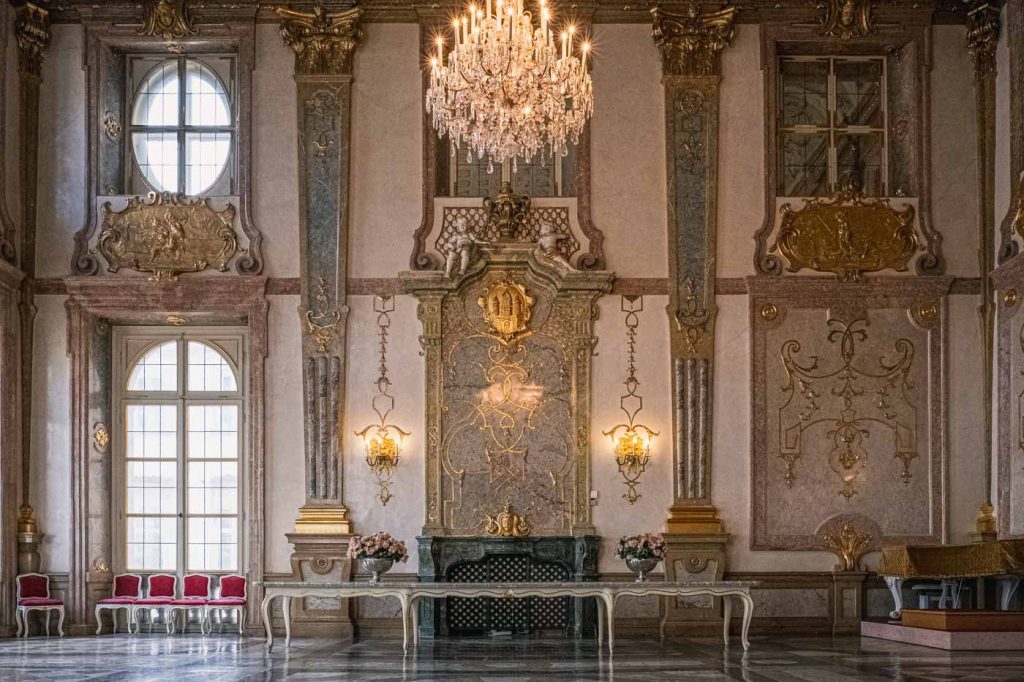
While Mirabell Gardens are more famous for their gardens, Mirabell Palace is world-famous for weddings. On average, 1200 weddings are held there each year. In the Marble Hall, couples come from all over the world to get married. Before 2020, Japanese couples getting married at the Marble Hall were often seen in horse carriages around the city.
What can you do at Mirabell Palace?
The fanciest part of Mirabell is the marble hall. The marble hall is also the only part of Mirabell we can visit. The rest of Mirabell is used for city government offices. Let’s make our way from the Pegasus Fountain through the so-called Wolf Dietrich Hall to the Angel Staircase and up to the first floor.
When you enter the palace and the Wolf Dietrich Hall, notice the satellite image on the floor! You can spend some time studying the satellite map before leaving the hall through the opposite door and immediately returning to the palace through the door to your left. That’s how you get to the Grand Staircase or the Angel Staircase. The angels are nice but more interesting are the statues.
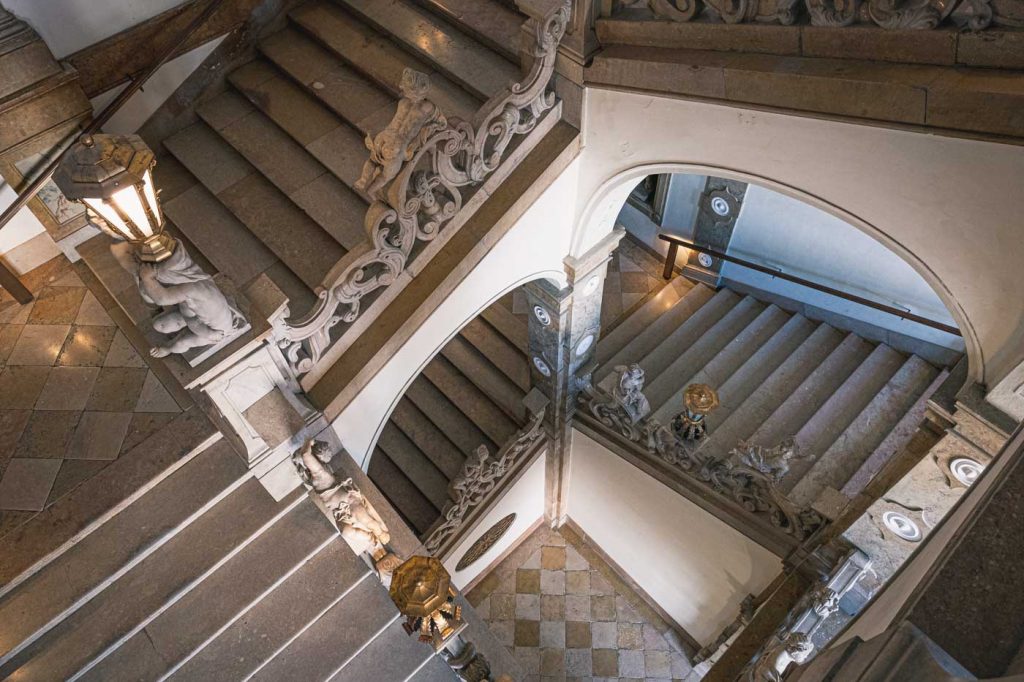
The statues lining the Staircase to the Marble Hall in Mirabell represent 11 more Greek and Roman statues. These statues continue a story that we have already begun in the garden. The story of the founding of Rome. From Anchises, whom we already met at the elements fountain where he fled the burning Troy with his father and son, to Caesar and his assassin Brutus. Here is the entire story and a guide to the statues, if you are interested.
The marble hall is on the first floor of the castle. Whether you can visit the marble hall depends on whether there is a wedding. Every year more than a thousand weddings take place at the marble hall.
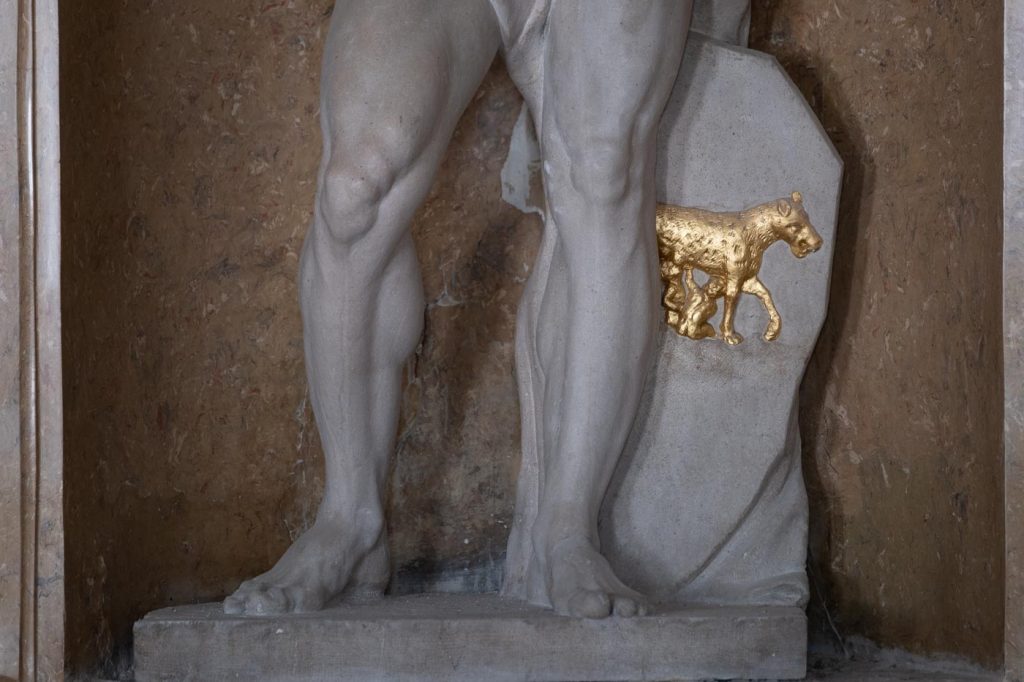
Usually, there is a barrier. Therefore, you can’t enter the Marble Hall all the way but far enough to see all of it. In the hall before the marble hall, there is sometimes a stand that sells tickets for the concerts in the evening. These concerts would be a way to enter the Marble Hall in the evening, in case you fancy that.
Here is an article on concerts in Salzburg on the Free Walking Tour Salzburg’s Blog and here is the link to book the Mirabell Palace Concerts.
Is Mirabell Palace free? Where to buy Mirabell Palace Tickets?
Admission to Mirabell Palace is free. Mirabell Palace does not charge an admission fee, nor do you need a ticket to enter. However, the majority of the Mirabell Palace is used by the Magistrate, the city government of Salzburg. You can enter the palace, see the Angel Staircase and climb it to reach the marble hall on the first floor.
It’s free to look at the Marble Hall, but you can only take two steps into the hall since it’s fenced off. There are only two ways to get all the way into the Marble Hall, and those are to attend a wedding or to attend a Mirabell Castle concert.
Where can you book tickets for the Mirabell Palace Concerts?
You can book tickets for the Mirabell Palace Concerts at the tourist information, at many hotel front desks or you can book your tickets for the Mirabell Palace Concerts here.
Is there a dress code for the Mirabell Palace Concerts?
The Mirabell Palace Concerts do not have a dress code. There are mostly tourists attending the concerts, so they aren’t going to be dressed up. I attended one of the concerts personally. I was wearing the most casual clothing one could wear and it was not a problem.
What to Do Nearby the Mirabell Gardens
Mirabell is within walking distance of Salzburg’s most popular attractions. Mirabell Garden is my first stop on most of my private tours, and my second stop on my Free Walking Tours is Mirabell Garden as well. Therefore, Mirabell Garden is also a good place to start your Salzburg exploration, if you are just getting started. Here is a guide to exploring Salzburg in 24 hours which also starts at Mirabell.

Just cross the river and head into Getreidegasse to find Mozart’s birthplace, and you’ll be just a few blocks away from two more of Salzburgs highlights, the Salzburg Cathedral and the Hohensalzburg Fortress.
More Questions & Answers
HOW LONG DOES IT TAKE TO VISIT MIRABELL PALACE?
It takes you 30 minutes to an hour to visit Mirabell Garden but visiting Mirabell Palace takes no more than 10 minutes. At Mirabell Palace you can’t do anything else than take the stairs to the first floor, open the door to the Marble Hall and have a look inside but only from the doorstep since there is a fence.
WHAT ELSE IS THERE TO SEE AT MIRABELL PALACE?
Normally, there would be a church next to the entrance facing the street, but it is always closed. It belongs to the old catholic church of Salzburg, a reform church of the roman catholic church. Services are held on Sundays at 10 a.m. If you wish to see the Mirabell church, you may attend. For me, it wouldn’t be worth it.
MIRABELL PALACE AND GARDENS OPENING TIMES
The Mirabell Gardens are open around the clock but the gates leading to the dwarf garden and the hedge theater close at sundown. The Orangerie is open from 9 am to 4 pm The garden remains open but there is not much artificial light at night.
Mirabell Palace and the Angel Staircase are open daily from 8 am to 6 pm.
The Marble Hall is officially open on Mondays, Wednesdays, and Thursdays from 8 am 4 pm and on Tuesdays and Fridays from 1 pm to 4 pm. Based on my experience as a local walking tour guide, the Marble Hall is also open the rest of the week and during random hours. However, especially in the summer months, the Marble Hall is very busy with weddings. You won’t be allowed in if you try to visit during a wedding.
IS MIRABELL GARDEN OPEN IN WINTER?
In winter, the gate at the Do-Re-Mi Steps, the dwarf garden, the hedge theater, and all the central areas of the grand and small parterres are closed. That sounds like everything is closed, but it isn’t. It is possible to enter either through the castle or through a door in the wall next to the Do-Re-Mi steps and walk along the castle and the garden wall to the other end of the garden. In this way, you can get a good idea of what the garden is about and see the four-element statue.
WHERE IN MIRABELL GARDEN WAS THE SOUND OF MUSIC FILMED?
The Mirabell Garden was mainly used for filming the Do-Re-Mi song, most famously when Maria jumps up and down the steps next to the palace when teaching the Do-Re-Mi. These stairs, therefore, are called the Do-Re-Mi steps. Other filming Sound of Music filming locations in Mirabell garden include the Pegasus Fountain in front of the Do-Re-Mi steps, one of the Dwarfs in the Dwarf Garden, and the gladiator statues at the entrance coming from Makartplatz, all of which were part of the walking tour above.
WHAT ELSE IS THERE TO SEE IN THE MIRABELL GARDENS?
As you exit the castle back into the garden, turn left to walk along the castle wall and you will come to a fence with roses planted behind it. Walk along the fence to find the entrance. In Mirabell garden, that entrance also makes for some great photos.
Continue walking along the fence outside the rose garden and turn right to walk along the wall. You will eventually reach an entrance on the left. In the middle of a fountain is a statue of a woman. She wears a feathered costume and is accompanied by birds. This is Papagena from Mozart’s Magic Flute. The statue was added in 1984 and was not part of the original gardens.
The palm house to the left was part of the original garden. During the day, it’s open and free for visitors. The entrance is on the left side of the building. The interior has a tropical climate. In winter, people can bring their turtles to live in the pond with the statue of the flute player and a birdcage. Yes, they can bring their real turtles to spend the winter in the palm house.


